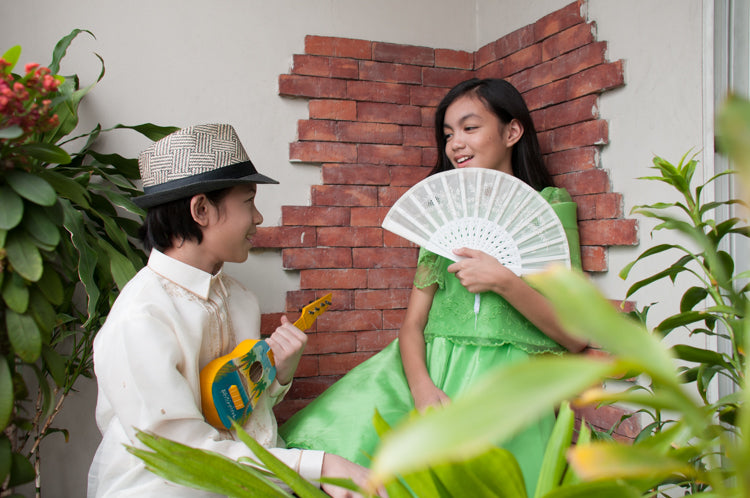By: Janice Guzman
Revisiting Traditional Filipino Clothing's Cultural Abundance
While the modern fashion industry is proud of its luxurious handcrafted garments from Chinese, Egyptian and Indian textiles and French or Belgian lace, traditional Filipino clothing is proudly made from pineapple and banana leaves. This tradition is ingrained in Filipino culture and has a lengthy history that many people are unaware of.
The traditional dress can reflect an individual's social status and ideals but also reflect allegiance and identity. Filipino attires were also influenced by the Philippines' significant colonial powers, including Spain, the United States, and Japan. As the official national costume of Filipino men, Barong Tagalog is a popular choice among public figures.
I will walk you through the transformation and illustrious history of Traditional Filipino Clothing, demonstrating how it has stood the test of time.
The golden years of the "terno"
Former first lady Imelda Marcos is often praised for popularizing the Terno concept of traditional Filipiniana dress in the 1970s. She also popularized the butterfly sleeve, which she still wears on public occasions. The "golden years of the terno" can be traced back to the 1930s, when Filipino culture was officially recognized. Terno is a Spanish term that translates as "to match."
Pacita Longos, one of pre-war fashion's leading designers, was initially credited with pioneering the flattened terno or "butterfly" sleeve trend. During ternos' fashion spotlight, Filipino original designs can also be seen in interiors, apparel, graphics, jewelry, and architecture, among other areas. terno's are still worn on special occasions today.
A made-to-order Filipiniana terno with butterfly sleeves is made available for you. It features a satin bodice with butterfly sleeves and skirts hand-painted by renowned artisans. Clothing that dates back further than many people alive will never go out of style.

Local talents, international craftmanship
Did you know that aristocratic women in Manila used to change their clothes four to six times daily? That is correct. During Manila's golden era, highly regarded dressmakers portrayed prominent traditional Filipino clothing.
Over the years, several well-known dressmakers have made a name for themselves. One of them is Juanita Mina Roa. She was Aurora Quezon's and Esperanza Escolar Limjap-Osmena's personal dressmaker. She is credited with inventing the detachable-sleeved two-in-one terno, like an evening gown worn in America.
Pitoy Moreno, dubbed "Asia's Fashion Czar," was the first Filipino to bring Philippine fashion to the international stage, with his designs appearing in Vogue, Harper's Bazaar, Holiday, and Le Figaro. He has designed traditional garments for celebrities worldwide, including former First Ladies of the United States, Nancy Reagan, and Pat Nixon.
Indeed, an increasing number of Filipino designers take pride in elevating traditional clothing to a global level of recognition. Due to the unique beauty and history of each baro't saya, the sector has become even more appealing to local and international fashion stars.
The brand has even gained a foothold in the pageant market, which is significant for the local designers. This magnificent Neoprene Mestiza Gown Red Filipiniana is reminiscent of the 1930s with a modern twist. A side slit was added to give you a more elegant and enchanting appearance. This is ideal for formal events, pageant nights, or if you simply want to look stunning!

The indivisibility of fashion and tradition
Each article of clothing has a story to tell. Fashion reveals how people lived and how other cultures influenced them. For over 300 years, the Philippines was colonized, explaining why there is so much Spanish influence. Pre-colonial Filipino women wore undergarments that exposed their upper extremities, demonstrating their pre-colonial lifestyle. Due to its cultural and religious significance, certain areas of the Philippines are similarly covered from head to toe. Since the Spanish took control of the country's majority, they established a uniform dress code to maintain an air of modesty.
The introduction of Spanish culture to the Philippines provoked a mixed reaction; some welcomed it, while others rejected it and maintained their pre-existing beliefs, particularly in religion. Fashion was heavily influenced initially, and while it has evolved significantly, it has added to the uniqueness of Filipino apparel.
The Philippine Kimona has gained popularity as a symbol of modern Filipina modesty. This is a popular item of clothing in the Visayan region, made of pineapple fiber. Consider this beige Filipiniana Kimona to project a modest aura while making a statement to your audience. They were made of organza (shell) and polyester for the undershirt.

The traditional Filipino clothing and the modern society
As one might expect, not all traditional garments have endured the test of time. Few households own a Barong Tagalog or "Terno," which were once considered standard Filipino casual attire. Compared to "Terno," the Barong Tagalog is more widely used because it is more comfortable to wear. Even though numerous organizations advocate its use, most are hesitant to patronize it since it is significantly more expensive than clothing manufactured or shipped from China.

Today's youth are enamored with their favorite artists, particularly Korean Pop Culture and Western fashion. While the government has made efforts to preserve old traditions through the education sector, they have had little impact. We have entered a new phase and determining how to protect our traditional clothing is significant.
A popular design competition called "Balik" "Saya" encourages aspiring designers to restore Filipino traditional attire to its natural state. Typically, this event is held at the National Museum of Natural History.
Our product, our commitment
Traditional Filipino Clothing is still alive today, with various organizations promoting it in the Philippines and worldwide. Due to the inseparable link between traditional dress and our culture, its preservation is critical. As with clothing, plants can be altered, but their natural state should always be preserved. This distinguishes us and instills pride in our ancestors.

You can help by promoting Filipino fashion by supporting local designers. Barong Warehouse is dedicated to the preservation of culture and heritage, carries the finest quality Barong Tagalog and Filipiniana attire. Our commitment is to keep the Filipino tradition alive while delivering quality and world-class garments.


Share:
The Filipiniana: Wedding Dress Reimagined
Kalinga Tradition: Weaving, Clothing, Accessories, and Tattoos
1 comment
Hi! can we use some lines from the article for research purposes? We will give full credit to this website and the author. Thank you!